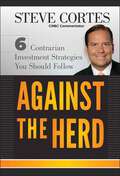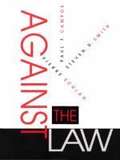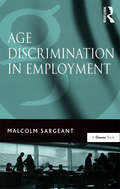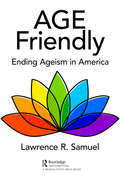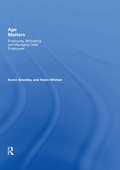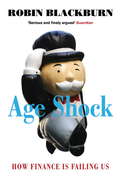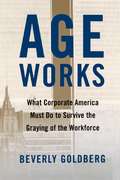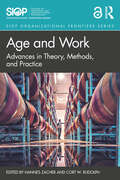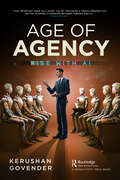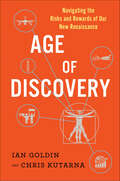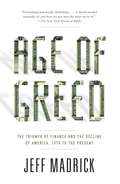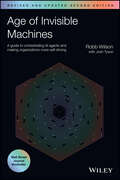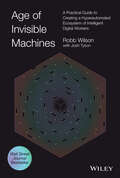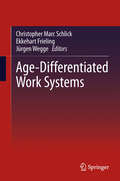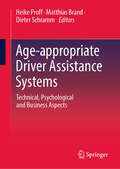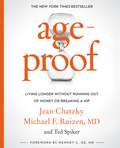- Table View
- List View
Against the Grain: Jim Teague in Tanzania (A)
by Karthik RamannaLoan officer Jim Teague discovers his agro-processor client has a serious health-code violation just days before a disbursement is due. Proceeding with the loan could jeopardize the health of thousands of customers and put his employer at serious risk. But withholding the loan will likely deprive hundreds of farmers affiliated with the agro-processor their livelihoods in this poor rural corner of Tanzania.
Against the Great Reset: Eighteen Theses Contra the New World Order
by the-Pipeline.orgMuch more than a collection of essays by eminent writers, Against the Great Reset is intended to kick off the intellectual resistance to the sweeping restructuring of the western world by globalist elites.In June 2020, prominent business and political leaders gathered for the 50th annual meeting of the World Economic Forum in Davos, Switzerland, under the rubric of &“The Great Reset.&” In the words of WEF founder Klaus Schwab, the Great Reset is a &“unique window of opportunity&” afforded by the worldwide COVID-19 panic to build &“a new social contract&” ushering in a utopian era of economic, social, and environmental justice. But beneath their lofty and inspiring words, what are their actual plans? In this timely and necessary book, Michael Walsh has gathered trenchant critical perspectives on the Great Reset from eighteen eminent writers and journalists from around the world. Victor Davis Hanson places the WEF&’s prescriptions and goals in historical context and shows how American politicians justify destructive policies. Michael Anton explains the socialist history of woke capitalism. James Poulos looks at how Big Tech acts as informal government censors. John Tierney lays out the lack of accountability for the unjustified panic over the virus. David Goldman confronts the WEF&’s ideas for a fourth industrial revolution with China&’s commitment to being the leader of a post-western world. And there are many more. These writers see the goal of the Great Reset as not just a world without racism, disease, economic inequality, or fossil fuels—but rather, a world with no individual autonomy and power in which our betters rig the system for their own purposes. Find out what the Great Resetters ultimately have in store for you, and join the intellectual resistance—before it&’s too late. Featuring Essays by: Michael Anton Salvatore Babones Conrad Black Jeremy Black Angelo Codevilla Janice Fiamengo Richard Fernandez David P. Goldman Victor Davis Hanson Martin Hutchinson Roger Kimball Alberto Mingardi Douglas Murray James Poulos Harry Stein John Tierney Michael Walsh
Against the Herd: 6 Contrarian Investment Strategies You Should Follow
by Steve CortesCNBC's Fast Money Commentator Steve Cortes shows how to buck the trend and become a well-informed investor The public needs to think independently and not be duped, particularly because those who are selling their messages or promoting their ideas have a plethora of powerful media through which to do so. Against the Herd presents six contrarian views of major events that will shape the future. Steve Cortes of CNBC pulls no punches in explaining these trends. Many will find his views counterintuitive and even controversial. Some will find his forecasts alarming. But open-minded readers who are willing to heed his well-informed advice will find it illuminating, beneficial, and profitable. Steve Cortes presents six contrarian views of major events that will shape the future for investors including the fall of China and the end of the golden era of free trade The contrarian stances are presented because they are actionable Reveals how these events will affect global markets and specific investments, and how and when to take advantage of these key moves Against the Herd shows you how to profit by bucking conventional wisdom and what to do to get ready when situations call for contrarian investing.
Against the Law
by Pierre Schlag Steven D. Smith Paul F. CamposA fundamental critique of American law and legal thought, Against the Law consists of a series of essays written from three different perspectives that coalesce into a deep criticism of contemporary legal culture. Paul F. Campos, Pierre Schlag, and Steven D. Smith challenge the conventional representations of the legal system that are articulated and defended by American legal scholars. Unorthodox, irreverent, and provocative, Against the Law demonstrates that for many in the legal community, law has become a kind of substitute religion--an essentially idolatrous practice composed of systematic self-misrepresentation and self-deception.Linked by a persistent inquiry into the nature and identity of "the law," these essays are informed by the conviction that the conventional representations of law, both in law schools and the courts, cannot be taken at face value--that the law, as commonly conceived, makes no sense. The authors argue that the relentlessly normative prescriptions of American legal thinkers are frequently futile and, indeed, often pernicious. They also argue that the failure to recognize the role that authorship must play in the production of legal thought plagues both the teaching and the practice of American law. Ranging from the institutional to the psychological and metaphysical deficiencies of the American legal system, the depth of criticism offered by Against the Law is unprecedented.In a departure from the nearly universal legitimating and reformist tendencies of American legal thought, this book will be of interest not only to the legal academics under attack in the book, but also to sociologists, historians, and social theorists. More particularly, it will engage all the American lawyers who suspect that there is something very wrong with the nature and direction of their profession, law students who anticipate becoming part of that profession, and those readers concerned with the status of the American legal system.
Against the Tide: An Intellectual History of Free Trade
by Douglas A. IrwinAbout two hundred years ago, largely as a result of Adam Smith's Wealth of Nations, free trade achieved an intellectual status unrivaled by any other doctrine in the field of economics. What accounts for the success of free trade against then prevailing mercantilist doctrines? And how well has free trade withstood various theoretical attacks that have challenged it since Adam Smith's time? In this readable intellectual history, Douglas Irwin explains how the idea of free trade has endured against the tide of the abundant criticisms that have been leveled against it from the ancient world and Adam Smith's day to the present. An accessible, nontechnical look at one of the most important concepts in the field of economics, Against the Tide will allow the reader to put the ever new guises of protectionist thinking into the context of the past and discover why the idea of free trade has so successfully prevailed over time. Irwin traces the origins of the free trade doctrine from premercantilist times up to Adam Smith and the classical economists. In lucid and careful terms he shows how Smith's compelling arguments in favor of free trade overthrew mercantilist views that domestic industries should be protected from import competition. Once a presumption about the economic benefits of free trade was established, various objections to free trade arose in the form of major arguments for protectionism, such as those relating to the terms of trade, infant industries, increasing returns, wage distortions, income distribution, unemployment, and strategic trade policy. Discussing the contentious historical controversies surrounding each of these arguments, Irwin reveals the serious analytical and practical weaknesses of each, and in the process shows why free trade remains among the most durable and robust propositions that economics has to offer for the conduct of economic policy.
Against the Troika
by Paul Mason Costas Lapavitsas Oskar Lafontaine Heiner Flassbeck Alberto Garzón EspinosaOn the 25th January 2015 the Greek people voted in an election of historic importance--not just for Greece but potentially all of Europe. The radical party Syriza was elected and austerity and the neoliberal agenda is being challenged. Suddenly it seems as if there is an alternative. But what? The Eurozone is in a deep and prolonged crisis. It is now clear that monetary union is a historic failure, beyond repair--and certainly not in the interests of Europe's working people. Building on the economic analysis of two of Europe's leading thinkers, Heiner Flassbeck and Costas Lapavitsas (a candidate standing for election on Syriza's list), Against the Troika is the first book to propose a strategic left-wing plan for how peripheral countries could exit the euro. With a change in government in Greece, and looming political transformations in countries such as Spain, this major intervention lays out a radical, anti-capitalist programme at a critical juncture for Europe. The final three chapters offer a detailed postmortem of the Greek catastrophe, explain what can be learned from it--and provide a possible alternative. Against the Troika is a practical blueprint for real change in a continent wracked by crisis and austerity.
Age Discrimination and Diversity: Multiple Discrimination from an Age Perspective
by Malcolm SargeantThis volume of essays is concerned with the discrimination against older people that results from a failure to recognise their diversity. By considering the unique combinations of discrimination that arise from the interrelationship of age and gender, pensions, ethnicity, sexual orientation, socio-economic class and disability, the contributors demonstrate that the discrimination suffered is multiple in nature. It is the combination of these characteristics that leads to the need for more complex ways of tackling age discrimination.
Age Discrimination in Employment (Employment Law Practice Ser.)
by Malcolm SargeantIncreased life expectancy and an ageing workforce have highlighted the problem of age discrimination in developed countries. Malcolm Sargeant's Age Discrimination in Employment is an encyclopedic guide for HR specialists and employment lawyers to the nature of age discrimination in the workplace in a number of countries, along with a discussion of the main thrust of employment law in this area, including an analysis of the Employment Equality (Age) Regulations 2006. The book opens with a consideration of what age discrimination is and how it manifests itself at the workplace and elsewhere. It also breaks discrimination down by age (discrimination against young, middle, and senior age employees) and explores multiple discrimination, including age and gender, ethnicity, sexual orientation, and disability. An important reference for HR departments, policy-makers and others concerned with organizational culture and development, discrimination, and social policy.
Age Friendly: Ending Ageism in America
by Lawrence R. SamuelAge Friendly: Ending Ageism in America is a rallying call to make the United States a more equitable and just nation in terms of age. "Age friendliness" means being inclusive towards older people as workers, consumers, and citizens, something that can’t be said to exist today. The United States and, especially, Big Business, are notoriously age-unfriendly places, a result of our obsession with youth. Virtually all aspects of everyday life in America will be impacted by the doubling or tripling of the number of older people over the next two decades, more reason to adopt age friendliness as a cause. Age Friendly shows how large companies are in an ideal position to address the aging of America and, in the process, benefit from making their organizations more age friendly. Because of its economic power and commitment to diversity in the workplace, Big Business—specifically the Fortune 1000—has the opportunity and responsibility to take a leadership role in changing the narrative of aging in America. The book shows that age friendliness offers the possibility of bridging gaps not just between younger and older people, but those based on income, class, race, gender, politics, and geography. More than anything else, Age Friendly presents a bold and counterintuitive idea—aging is a positive thing for businesses, individuals, and society as a whole—and we should embrace it rather than fear it. While ageism is a pervasive force in America that, like racism and gender discrimination, runs contrary to our democratic ideals, there is some good news. An age friendly movement is spreading in America and around the world as a growing number of cities and towns strive to better meet the needs of their older residents. Aa well, a concerted effort is being made to convince Big Business that an intergenerational workforce is in the best interests of not just older employees but the companies themselves. Age brings experience, perspective, and wisdom—just the right skill set for both short- and long-term decision-making. The aging of America also presents major implications for businesses in terms of marketing to older consumers. Baby boomers are still the key to the economy despite marketers’ focus on youth, much in part to their collective wealth and propensity to consume. Age friendly marketing thus makes much sense due to "the longevity economy," i.e., the billions of dollars that older consumers spend each year and the goldmine that looms in the future as they become an even bigger percentage of the population. Finally, Age Friendly discusses how more corporations are pursuing social responsibility in addition to maximizing profits—an ideal opportunity for corporations to demonstrate good citizenship by supporting age friendliness on a local, state, or national level.
Age Matters: Employing, Motivating and Managing Older Employees
by Keren SmedleyKeren Smedley and Helen Whitten's Age Matters provides a comprehensive, innovative and positive approach to recent changes in the regulations and in demography. The authors explain the advantages and disadvantages of the 2006 legislation and its effect on current retirement practices. Packed with statistics and perspectives on the ageing workforce (in the UK, EU and countries around the world), the book includes practical advice, models, exercises and training activities to help establish an appropriate response for your organisation. It is those organisations who can look beyond the legislation to manage the value in their older workforce that will thrive. Use this book to understand the implications of demographic change and the employment law issues it raises; to help older employees identify, articulate and adapt to new ways of working; to enable both older and younger employees to work across the generations; and to build an age-inclusive culture. Covering virtually every human resources issue related to the ageing employment pool, this is a must-have resource for anyone involved in human resources, employment planning, organisational development and training.
Age Of Fracture
by Daniel T. RodgersIn the last quarter of the twentieth century, the ideas that most Americans lived by started to fragment. Mid-century concepts of national consensus, managed markets, gender and racial identities, citizen obligation, and historical memory became more fluid. Flexible markets pushed aside Keynesian macroeconomic structures. Racial and gender solidarity divided into multiple identities; community responsibility shrank to smaller circles. In this wide-ranging narrative, Daniel Rodgers shows how the collective purposes and meanings that had framed social debate became unhinged and uncertain. Age of Fracture offers a powerful reinterpretation of the ways in which the decades surrounding the 1980s changed America. Through a contagion of visions and metaphors, on both the intellectual right and the intellectual left, earlier notions of history and society that stressed solidity, collective institutions, and social circumstances gave way to a more individualized human nature that emphasized choice, agency, performance, and desire. On a broad canvas that includes Michel Foucault, Ronald Reagan, Judith Butler, Charles Murray, Jeffrey Sachs, and many more, Rodgers explains how structures of power came to seem less important than market choice and fluid selves. Cutting across the social and political arenas of late-twentieth-century life and thought, from economic theory and the culture wars to disputes over poverty, color-blindness, and sisterhood, Rodgers reveals how our categories of social reality have been fractured and destabilized. As we survey the intellectual wreckage of this war of ideas, we better understand the emergence of our present age of uncertainty.
Age Related Pension Expenditure and Fiscal Space: Modelling techniques and case studies from East Asia (Routledge-ERIA Studies in Development Economics)
by Mukul G. Asher Fauziah ZenThis book explores the linkages between age-related pension expenditures and the fiscal space needed to fund them, as well as to organize the mix of financing methods with different risk-sharing arrangements. After critically assessing the existing models projecting age-related expenditure in the literature, the book focuses on the case studies of these inter-linkages in four highly-populated East Asian countries, namely China, Indonesia, India, and Japan. Nearly two- fifths of the global population live in these countries. Therefore, how these inter-linkages manifest themselves and the initiatives in these countries for finding fiscal space will have an impact on how the ageing issues are addressed globally. This book does several distinguishing characteristics, including exploration of inter-linkages between age-related expenditure and fiscal space, and application of country-specific methods to explore these linkages, rather than relying standard macroeconomic model. In the process, the studies also bring out the limitations of standardized model used in the literatures. Scholars and policy makers interested in the subject will definitely find the book of valuable use.
Age Shock
by Robin BlackburnMost countries face the future with an ageing population, yet most governments are cutting back on pensions and the care services needed by the elderly. Robin Blackburn exposes the perverse reasoning and special interests which have combined to produce this nonsensical state of affairs. This updated paperback edition of Age Shock includes a new preface explaining why the credit crunch and eurozone crisis have had such a devastating impact and outlining a way to guarantee decent pensions and care provision.
Age Works
by Beverly GoldbergIn ten years, the massive baby-boom generation will begin to reach retirement age, but few companies have paid attention to the fact that there are not enough younger workers to replace them. The challenge to corporate America, as Beverly Goldberg argues in Age Works, is to reinvent the workplace to make it better fit the needs of all employees, especially the older workers it must retain in order to thrive.
Age and Work: Advances in Theory, Methods, and Practice (SIOP Organizational Frontiers Series)
by Cort W. Rudolph Hannes ZacherThe edited volume Age and Work: Advances in Theory, Methods, and Practice presents a systematic collection of key advances in theory, methods, and practice regarding age(ing) and work. This cutting-edge collection breaks new ground by developing novel and useful theory, explaining underutilized but important methodological approaches, and suggesting original practical applications of emerging research topics. The book begins with a prologue by the World Health Organization’s unit head for aging and health, an introduction on the topic by the editors, and an overview of past, current, and future workforce age trends. Subsequently, the first main section outlines theoretical advances regarding alternative age constructs (e.g., subjective age), intersectionality of age with gender and social class, paradoxical age-related actions, generational identity, and integration of lifespan theories. The second section presents methodological advances regarding behavioral assessment, age at the team and organizational levels, longitudinal and diary methods, experiments and interventions, qualitative methods, and the use of archival data. The third section covers practical advances regarding age and job crafting, knowledge exchange, the work/nonwork interface, healthy aging, and absenteeism and presenteeism, and organizational meta-strategies for younger and older workers. The book concludes with an epilogue by an eminent scholar in age and work. Written in a scientific yet accessible manner, the book offers a valuable resource for undergraduate and graduate students, academics in the fields of psychology and business, as well as practitioners working in the areas of human resource management and organizational development.
Age of Agency: Rise with AI
by Kerushan Govender"When the digital world started, many companies moved slowly and cautiously, not willing to replace their traditional operations. Now most companies have gone digital. We are now moving beyond digital into an AI world. Don't ignore it. This important book will guide you by providing a fresh perspective on the interrelationships between humans and AI." – Philip Kotler Do you feel overwhelmed by the AI wave? Worried that it could cost you your job, harm your business, or even take over? AI has pervaded our lives and is aggressively disrupting business. No person today can afford to ignore AI. Age of Agency is your companion, helping you leverage AI's capabilities to power your productivity and success. By understanding AI, you will learn to use it as a tool for personal career growth and business success. Former Microsoft executive Kerushan Govender demystifies AI, emphasising the importance of human agency. Reconnect with the needs of humanity and learn the importance of care as a differentiator in an AI world. Avoid the potential pitfalls of excessive reliance on the technology. Age of Agency is a blueprint for ensuring human agency outpaces computer agency. It boldly pits the limits of machine learning against the infinity of human ability. With this survival guide, you’ll uncover ways to connect with humanity on a deeper level, going beyond anything AI can do. Ready to become AI-savvy, with your humanity as your differentiator? Dive into the future with the confidence to ride the wave of today’s AI revolution.
Age of Ambition: Chasing Fortune, Truth, and Faith in the New China
by Evan OsnosWinner of the 2014 National Book Award in nonfiction. An Economist Best Book of 2014. A vibrant, colorful, and revelatory inner history of China during a moment of profound transformation From abroad, we often see China as a caricature: a nation of pragmatic plutocrats and ruthlessly dedicated students destined to rule the global economy-or an addled Goliath, riddled with corruption and on the edge of stagnation. What we don't see is how both powerful and ordinary people are remaking their lives as their country dramatically changes  As the Beijing correspondent for The New Yorker, Evan Osnos was on the ground in China for years, witness to profound political, economic, and cultural upheaval. In Age of Ambition, he describes the greatest collision taking place in that country: the clash between the rise of the individual and the Communist Party's struggle to retain control. He asks probing questions: Why does a government with more success lifting people from poverty than any civilization in history choose to put strict restraints on freedom of expression? Why do millions of young Chinese professionals-fluent in English and devoted to Western pop culture-consider themselves "angry youth," dedicated to resisting the West's influence? How are Chinese from all strata finding meaning after two decades of the relentless pursuit of wealth? Writing with great narrative verve and a keen sense of irony, Osnos follows the moving stories of everyday people and reveals life in the new China to be a battleground between aspiration and authoritarianism, in which only one can prevail.
Age of Discovery: Navigating the Risks and Rewards of Our New Renaissance
by Ian Goldin Chris KutarnaThe present is a contest between the bright and dark sides of discovery. To avoid being torn apart by its stresses, we need to recognize the fact—and gain courage and wisdom from the past. Age of Discovery shows how.Now is the best moment in history to be alive, but we have never felt more anxious or divided. Human health, aggregate wealth and education are flourishing. Scientific discovery is racing forward. But the same global flows of trade, capital, people and ideas that make gains possible for some people deliver big losses to others—and make us all more vulnerable to one another. Business and science are working giant revolutions upon our societies, but our politics and institutions evolve at a much slower pace. That’s why, in a moment when everyone ought to be celebrating giant global gains, many of us are righteously angry at being left out and stressed about where we’re headed.To make sense of present shocks, we need to step back and recognize: we’ve been here before. The first Renaissance, the time of Columbus, Copernicus, Gutenberg and others, likewise redrew all maps of the world, democratized communication and sparked a flourishing of creative achievement. But their world also grappled with the same dark side of rapid change: social division, political extremism, insecurity, pandemics and other unintended consequences of discovery.Now is the second Renaissance. We can still flourish—if we learn from the first.
Age of Greed: The Triumph of Finance and the Decline of America, 1970 to the Present
by Jeff MadrickA vividly told history of how greed bred America's economic ills over the last forty years, and of the men most responsible for them.As Jeff Madrick makes clear in a narrative at once sweeping, fast-paced, and incisive, the single-minded pursuit of huge personal wealth has been on the rise in the United States since the 1970s, led by a few individuals who have argued that self-interest guides society more effectively than community concerns. These stewards of American capitalism have insisted on the central and essential place of accumulated wealth through the booms, busts, and recessions of the last half century, giving rise to our current woes.In telling the stories of these politicians, economists, and financiers who declared a moral battle for freedom but instead gave rise to an age of greed, Madrick traces the lineage of some of our nation's most pressing economic problems. He begins with Walter Wriston, head of what would become Citicorp, who led the battle against government regulation. He examines the ideas of economist Milton Friedman, who created the plan for an anti-Rooseveltian America; the politically expedient decisions of Richard Nixon that fueled inflation; the philosophy of Alan Greenspan, on whose libertarian ideology a house of cards was built on Wall Street; and the actions of Sandy Weill, who constructed the largest financial institution in the world, which would have gone bankrupt in 2008 without a federal bailout of $45 billion. Significant figures including Ivan Boesky, Michael Milken, Jack Welch, and Ronald Reagan play key roles as well.Intense economic inequity and instability is the story of our age, and Jeff Madrick tells it with style, clarity, and an unerring command of his subject.From the Hardcover edition.
Age of Invisible Machines: A Guide to Orchestrating AI Agents and Making Organizations More Self-Driving, Revised and Updated
by Robb Wilson Josh TysonCut through the noise and unlock the transformational power of conversational AI In the newly revised second edition of Age of Invisible Machines, renowned tech leader Robb Wilson delivers a startlingly insightful and eye-opening blueprint for using conversational AI to make your company self-driving—with a digital ecosystem of interconnected automations powering all aspects of your business. Conversational AI is transforming every job at every company (starting yesterday) and this book is perfect for anyone affected by these technologies. You'll learn how to develop a hyperautomation strategy by identifying outdated processes and systems holding your company back. This latest edition offers brand new chapters dedicated to fast-growing automation tools, including Large Language Models, generative AI, and much more. You'll discover ways to implement new technologies that are force-multipliers for rapid growth. A must-read for every business leader, Wilson's book debunks common myths about conversational AI while simplifying the inevitable complexity of restructuring your business to unlock the substantial opportunities this new era offers. You'll also find: Incisive discussions of the ethical dilemmas that lie before us as mass adoption of conversational AI takes effect Fascinating examinations of what a self-driving business looks like and how you can use conversational AI to generate an enduring competitive advantage Strategies for creating a hyperautomated ecosystem that any company can begin using immediately QR links to interactive and ongoing discussions of the subjects covered in each chapter A practical and essential exploration of the future of conversational AI and hyperautomation, Age of Invisible Machines belongs in the hands of entrepreneurs, founders, business leaders, tech enthusiasts, designers and anyone else with a stake in the future of business.
Age of Invisible Machines: A Practical Guide to Creating a Hyperautomated Ecosystem of Intelligent Digital Workers
by Robb WilsonCut through the hype and unlock the game-changing potential of conversational AI. In Age of Invisible Machines, celebrated tech leader Robb Wilson delivers an eye-opening and startlingly insightful blueprint for leveraging conversational AI in order to make your organization self-driving—with a growing ecosystem of interconnected automations accelerating all aspects of your business. Conversational AI is changing the nature of every job at every company (starting yesterday) and this book is relevant for anyone who will be affected by the acceleration of these technologies. You&’ll learn how to develop a strategy for hyperautomation by identifying the outdated processes and systems holding your organization back. You&’ll discover ways of internalizing and orchestrating new technologies that are force-multipliers for rapid growth. A must-read for every business leader, Wilson&’s book debunks common myths about conversational AI while laying bare the inevitable complexity of restructuring your business to unlock the massive opportunities this new era affords. You&’ll also find: Compelling discussions of the ethical dilemmas that lie in wait as mass adoption of conversational AI takes hold Fascinating explorations of what a self-driving organization looks like and how you can use conversational AI to create a durable competitive advantage Strategies behind creating an ecosystem for hyperautomation that any company can begin implementing immediately QR links to ongoing, interactive online discussions of the material covered in each chapter An essential and practical discussion of the future of conversational AI and hyperautomation, Age of Invisible Machines belongs in the hands of founders, entrepreneurs, business leaders, designers, tech enthusiasts, and anyone else with a stake in the future of business.
Age of Marshall: Aspects of British Economic Thought
by Narmedeshwar JhaFirst published in 1973. This is the second edition and nine years after when The Age of Marshall was first published. The period 1890-1915 in the history of British Economic Thought may aptly be described as the Age of Marshall. His influence as teacher, and his ideas as presented in the Principles of Economics (1890) and other writings, stimulated and often dominated the ideas and writings of most of the younger economists of the period. His ideas also provided a theoretical basis for increasing state intervention in economic life of the community in Britain and thus helped the Liberal Government of Great Britain lay the foundations of a Welfare State.
Age-Differentiated Work Systems
by Christopher Marc Schlick Ekkehart Frieling Jürgen WeggeThe disproportionate aging of the population of working age in many nations around the world is a unique occurrence in the history of humankind. In the light of demographic change, it is becoming increasingly important to develop and use the potential of older employees. This edited volume Age-differentiated Work Systems provides a final report on a six-year priority program funded by the German Research Foundation (DFG) and presents selected research findings of 17 interdisciplinary project teams. The idea is that it will serve both as a reference book and overview of the current state of research in ergonomics, occupational psychology and related disciplines. It provides new models, methods, and procedures for analyzing and designing age-differentiated work systems with the aim of supporting subject matter experts from different areas in their decisions on labor and employment policies. Therefore over 40 laboratory experiments involving 2,000 participants and 50 field studies involving over 25,000 employees were conducted. Further objectives of the edited volume were to provide a pluridisciplinary compilation of the extensive information acquired over the six-year program period, to illustrate the range of the research field, and to convey an integrated understanding of age-differentiated work systems to readers.
Age-appropriate Driver Assistance Systems: Technical, Psychological and Business Aspects
by Dieter Schramm Heike Proff Matthias BrandPeople in highly developed countries are getting older and older. They want to be mobile in old age, but often have problems in road traffic. Even though they often pay a premium for age-appropriate products that increase safety, the demand for driver assistance systems among older drivers has so far been low. This book summarises the results of the ALFASY (ALtersgerechte FAhrerassistenzSYsteme) project, in which an acoustic driver assistance system is being developed and built to meet the needs of the steadily growing group of older drivers. Technical, psychological and economic aspects were investigated.
AgeProof: Living Longer Without Running Out of Money or Breaking a Hip
by Michael F. Roizen Mehmet C. Oz Jean Chatzky Ted SpikerTwo of the world's leading experts explain the vital link between health and wealth that could add years to your life and dollars to your retirement savings.All the money in the world doesn't mean a thing if we can't get out of bed. And the healthiest body in the world won't stay that way if we're frazzled about five figures worth of debt. TODAY Show financial expert Jean Chatzky and the Cleveland Clinic's chief wellness officer Dr. Michael Roizen explain the vital connection between health and wealth--giving readers all the tactics, strategies, and know-how to live longer, healthier, more lucrative lives. The same principles that allow us to achieve a better body will allow us to do the same for our investment portfolio. For instance, physical and financial stability comes down to the same equation: Inflow versus outflow. Do we burn more calories than we ingest? Likewise, are we making more money than we spend? The authors detail scientific ways to improve our behavior so that the answers tilt in the readers' favor. They also offer ways to beat the system by automating how we do things and limiting our decisions in the face of too much food or too much debt. Chatzky and Roizen provide a plan for both financial independence and biological strength with action steps to get you there.


